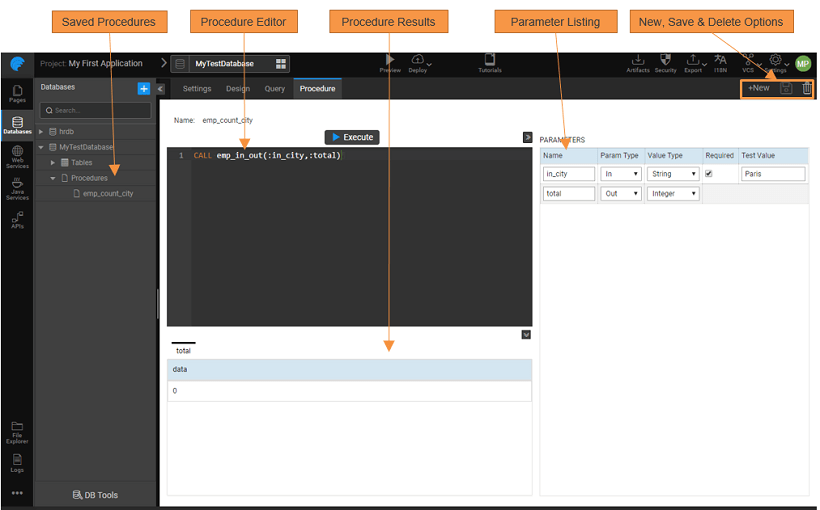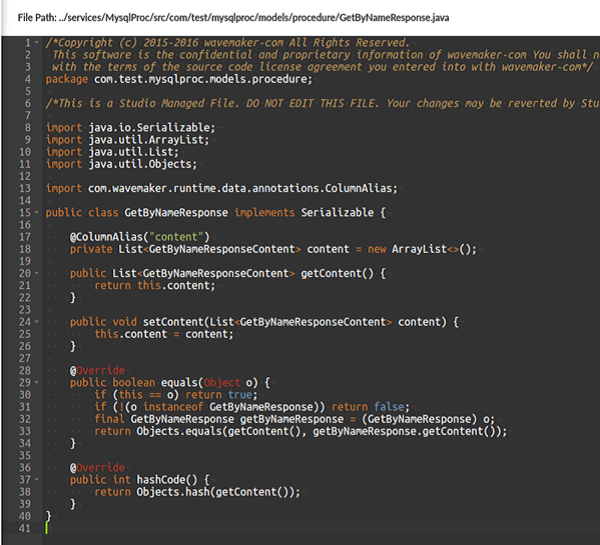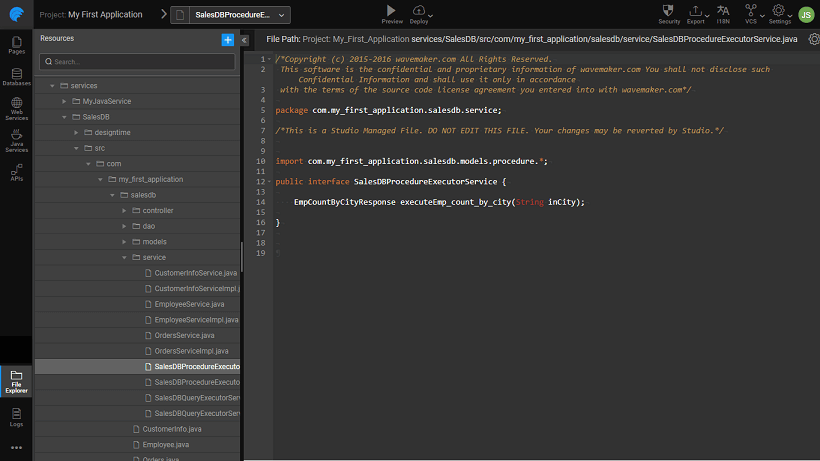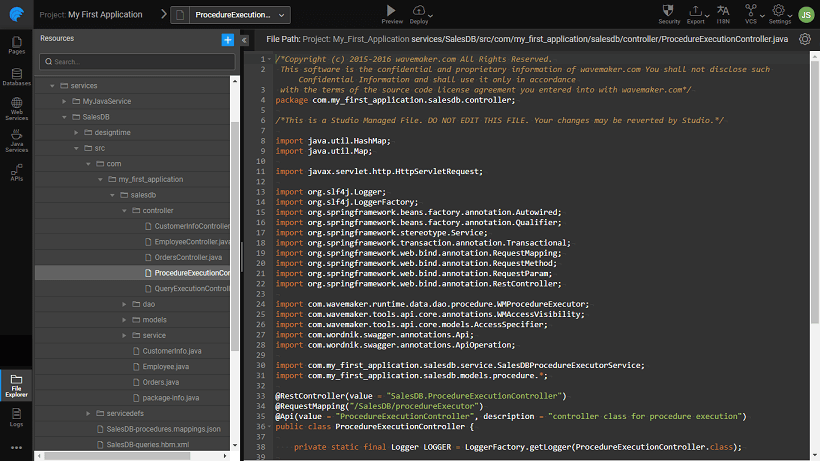Working with Stored Procedures
There will be times when you want to display data from multiple tables or update/insert values into multiple tables. Queries and Stored Procedures come in handy in such instances. WaveMaker provides editors for Queries & Procedures for integrating them with the WaveMaker applications. Each query & procedure used in the WaveMaker application will be exposed as a REST API for the UI to consume and render the data.
A stored procedure is a prepared SQL code that you save in your database so you can reuse the code over and over again.
Procedure tab from WaveMaker Database Designer can be used to execute procedures that are written in and imported from the database using the call command. Execute the procedure calls and save them for the usage within the app by creating Variable using the generated APIs.
Procedure Parameters
Calling Procedure will add the specified parameters. You can select the appropriate Parameter Type:
- IN for input parameter;
- OUT for output parameter; and
- IN-OUT for a combination parameter.
Parameter Type
- You can specify the data type for each of the parameter.
Some data types might be specific to the underlying database being implemented, for example, cursor data type is available only for Oracle database.
- You can also set the parameter type as one of Server Side Properties.
When you select this option while executing the procedure, the appropriate value is taken from the application rather than from user.
Currently supported server defined properties are:
- Logged in User Id
- Logged in User Name
- Current Date
- Current Time
- Current Date Time
See here on how Blob types are handled.
Parameters can also be set to App Environment Properties which can be configured differently for different runtime environments (learn more).
Defined & Undefined Cursors (Resultset)
Along with the configured OUT parameters, procedures can also return ResultSet (cursor), which is referred to as Undefined Cursor. When any procedure is returning Undefined Cursor, in Response an extra property is generated with name Content. A POJO also will be generated for that Response.
WaveMaker supports the execution of procedures/functions written using PL/SQL. You can find out more about Stored Procedures here. In this section, we will be seeing how WaveMaker supports Stored Procedures with the help of an example. We are using a MySQL database.
There are two aspects to stored procedure usage - Creation and Invocation:
Creation of Procedures and Functions
Procedure/Function needs to be created in the database itself. For MySQL DBs, you can use the DB Shell tab of DB Tools. Any procedures you have in a database that you import will be available for use.
- The database we used contains an Employee table with EmpID, Name and City details. Here is the _Employee table that we have designed using the DB Designer.
- The procedure entered in the DBShell under DB Tools would be:
A function would be:
Invocation of Procedures Functions from WaveMaker app
Procedures created in a DB can be accessed by creating a live service variable and associating it with the invocation of the procedure. Follow the steps given below to do the same: NOTE: This post explains the usage of stored procedures/functions in WaveMaker using the MySQL code. For the usage in different databases check here.
- In the Database Designer, select the Procedure tab, use the following code to invoke the above procedure.
Use the following code to invoke the function:
Post 8.4.1 release, you can use CTRL+space to select from a list of Procedures available in the database.
This will add the parameters. Select the appropriate options -
- IN for input parameter;
- OUT for output parameter; and
- IN-OUT for a combination parameter.
Specify the data type for each of the parameter.
See here for handling Blob types.
Some data types might be specific to the underlying database being implemented, for example, cursor data type is available only for Oracle database.
Save the procedure.
Create a variable using the Database API generated on the save of the procedure. This variable will expose the parameters for binding. More on Variable Creation
To use the Procedure, create a page with
- an input text box - to accept the city name to be bound to the input parameter of the above procedure and
- label to display the result.
The in parameter is bound to the datavalue property of the text box from the Variables dialog
The out parameter for display by binding to any widget property variable, here we are binding to the caption of a label.
Preview the app.
DB Specific Invocation
- MySQL/DB2 - the above documentation uses MySQL.
- Oracle - same as MySQL. In case, procedures are bundled in a package, need to prefix the package name to the proc_name.
- PostgreSQL - can be same as above or
- MSSQL & SQLServer- Invoking Procedures:
Invoking Functions:
Procedure Architecture
For all queries and procedures, there will be a Rest API generated with the Service layer. Along with the API, depending on the query or procedure type, request and response POJO classes are generated.
Understanding generated Code File structure
Models
Both Request and Response POJO classes are generated as: <procedureName>Request/Response
- These classes are generated in a package:
<service_packagegt;.models.procedure - Response classes generated for all procedures having at least one return property i.e OUT parameter or cursor.
Example: a procedure with name getEmployees will generate GetEmployeesResponse class with the returned columns.
- For Procedures not returning any properties, no POJO is generated, instead, Void is used as return type in the Service layer.
4. For Procedures returning Cursor(s)
- For each cursor, new POJO class gets generated with the name Response.
Example: procedure with name getStudents with cursor parameter marks, the POJO generated will be GetStudentsResponseMarks.
The generated type will be used in <procedureResponse> class with given property name. In the above-mentioned case, it will be marked with type GetStudentsReponseMarks.
- In the case of Undefined cursor returned i.e cursor not specified in parameters section.
- using the field as
contentthe POJO class will be generated as per the above case.
- using the field as
- Request classes will be generated for all procedures, with names starting
create,build,add,update,edit,set.
Services
This layer exposes the methods related to the configured query and procedures. Controller layer uses these methods to complete the user requests.
We recommend using methods from this layer in custom Java services.
- Class with name ProcedureExecutorService is generated in the .service package. For eg: for service hrdb, class name will be HrdbProcedureExecutorService.
- Method with name execute <procedureName> will be generated for all configured procedures.
- As mentioned in Models -> Procedures naming convention, if Request type generated for that procedure it will expected as argument otherwise all IN parameters expects as arguments.
- Response type will be <procedureName> Response. In case of procedure not returning any properties it uses Void
Controller
- Controller class with name ProcedureExecutorController in package .controller.
- Rest API is generated for each configured query and procedure. Generated method signature will be same as service layer method signature.




